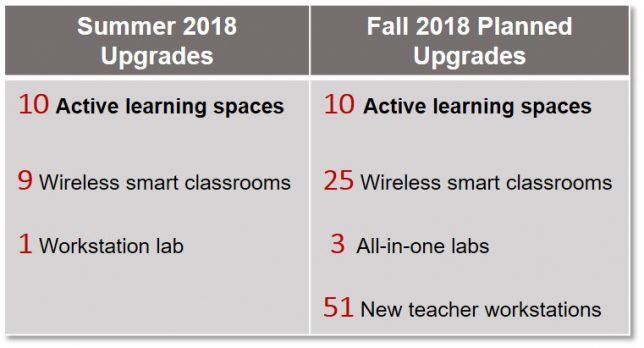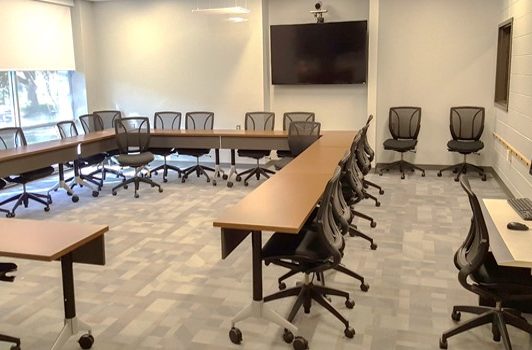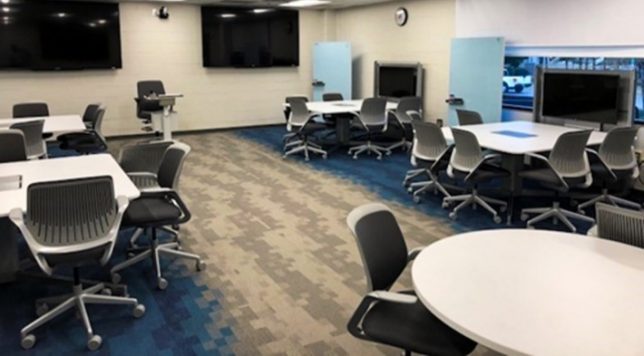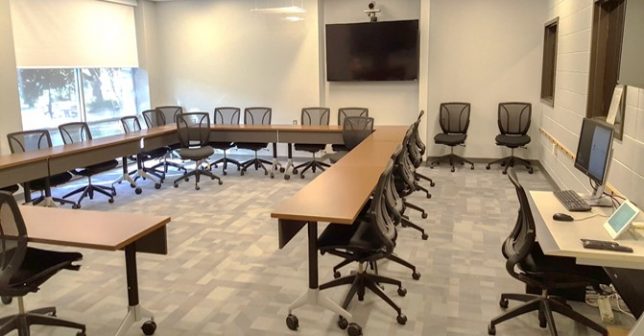ACTIVE LEARNING SPACES @ VSU
Written by Benjamin Li, Assistant Director of IT Services
What do you envision when you think of a classroom? Traditionally, people imagine rows of desks with an instructor standing or seated at a larger desk or podium at the front of the room. There may be a projector or a whiteboard where content is displayed. The instructor shares their expertise while students take notes, supplementing what they learned with activities they complete at home. While this is the type of classroom design that is conducive for a lecture-based pedagogy, what if your classroom could be this and more?
Picture a classroom where the instructor could still position seating into rows for a lecture, but could also change the arrangement as-needed into a circle where students and the instructor could feel like equals in a discussion.
Active learning spaces promote and enhance collaboration and interaction, while still supporting more traditional teaching styles.
The next day, the instructor could assign students to tables where they could work together as a group and then share their group’s results, through a projector or series of televisions, with rest the class. Later that day, the instructor may ask learners to individually perform some online research through their own personal laptops and mobile devices and then may call on volunteers to share their results on the big screen while leading a class discussion.
There are limitless methods and practices for teaching; and in the 21st century, a classroom that only supports one is inadequate for higher learning. As a result, VSU has adopted an active learning space concept and IT has helped to bring that concept to fruition.
In Fall 2017 and Spring 2018, VSU Division of Information Technology, working closely with faculty from the Department of Communication Arts, designed and built their first active learning space classroom.
The Communication Arts classroom contains four student hubs, which are tables with attached televisions that can be shared by students. Students can bring their own laptops and mobile devices, and in just a few clicks, can wirelessly project what they see on their own device to the television screen. If the instructor wants the whole class to see one group’s screen, they can click a button on a remote control that corresponds to that hub, and the image is shared to each hub’s television as well as two larger televisions at the front of the room.
Each hub also has a whiteboard that students can use to brainstorm. Finally, the classroom has a camera and microphone system to facilitate collaboration with distance learners. Since the chairs, whiteboards, and the instructor’s podium are on wheels, the furniture can be moved into an arrangement that supports the faculty member’s pedagogy with minimal loss of instructional time.
Technical Support Services is taking a proactive approach towards implementing active classroom environments throughout the VSU academic spaces. Our division is committed to applying innovation and diverse learning by allowing students and teachers to collaborate wirelessly through their mobile devices.
–Sterlin Sanders, director of TSS
As a result of IT Classroom Support and Network Services staff’s diligence in ensuring a worry-free experience for both instructors and students in the existing active learning classrooms, other VSU departments have now expressed interest in transforming their classrooms and learning spaces.


